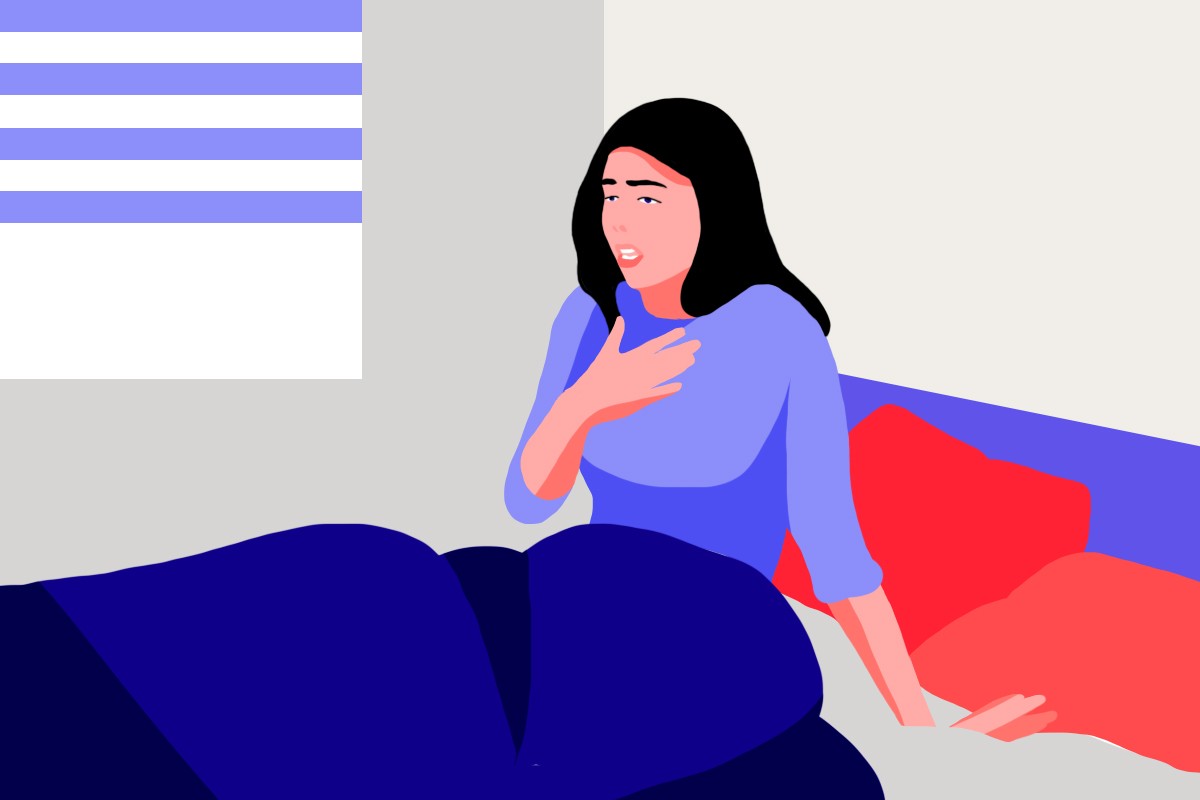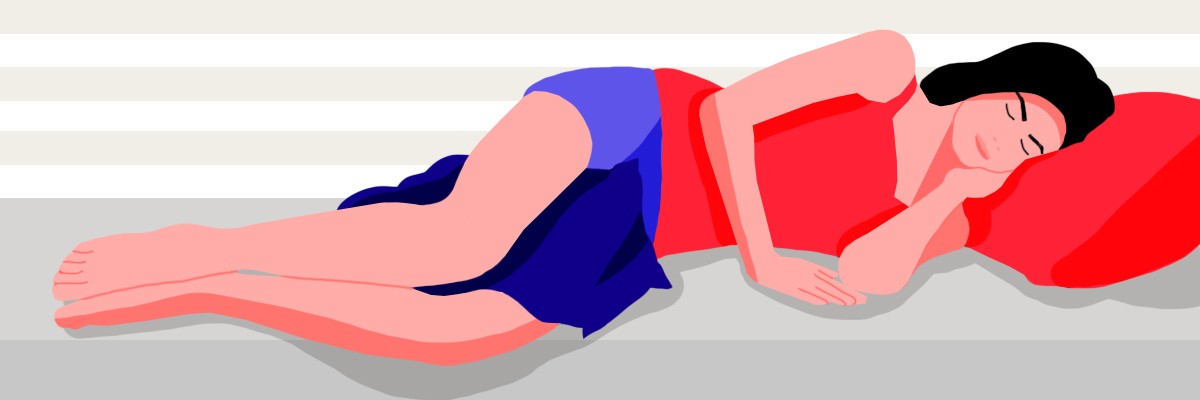How to Find the Best Sleeping Position for Asthma Relief

Discover the best sleeping position for asthma relief and improved sleep quality. Learn how to manage nocturnal asthma attacks and get the rest you need.
Are you dealing with asthma? In that case, it's important to be mindful of how you sleep. Identifying the best sleeping position for asthma may help minimize the symptoms.
Studies have shown that some sleeping positions are more helpful than others when it comes to managing asthma. In this article, we'll also discuss what asthma is and how it can affect you while you sleep.
Table of Contents
What is Asthma?
Asthma is a long-term respiratory illness. It causes inflammation and constriction of the airways. This can lead to symptoms like difficulty breathing, coughing, wheezing, chest tightness, and shortness of breath.
Causes
Experts still haven’t determined the exact causes of asthma but some factors can put you at risk. These include:
-
Viral respiratory infections
-
Smoking
-
Allergies (like eczema or rhinitis)
-
It runs in the family
-
Pollution
-
Obesity
Symptoms
Asthma can be an annoyance for a few. But for others, it can get in the way of their day-to-day lives. Or even worse, come in the form of a life-threatening asthma attack. Here are the main symptoms:
-
Wheezing (common in kids)
-
Coughing
-
Feeling short of breath
-
Pain or tightening in the chest
-
Poor sleep caused by the above factors
Triggers
Those with asthma can experience symptoms only occasionally or daily. According to the CDC, these are triggers for asthma(1):
-
Dust mites
-
Exercise
-
Cigarette smoke
-
Pests (like roaches)
-
Pet dander
-
Mold
Diagnosis and Treatment of Asthma
If you suspect you have asthma, don’t self-diagnose. Make sure to see your doctor. It’s a potentially life-threatening condition that needs proper treatment.
You’ll likely discuss your history and undergo a medical exam. One or more pulmonary function tests are also a possibility.
Spirometry is a type of breathing test that determines the amount of air you can breathe in and out of your lungs and how easily and quickly you can exhale.
Trigger tests determine what irritants you are sensitive to. And a FeNO test will tell you if your airways are inflamed.
In terms of treatment, you and your doctor will work towards creating an asthma action plan. You’ll likely be prescribed an inhaler, a device that contains medicine that is inhaled through the mouth.
More severe asthma cases may need tablets or syrups. These may contain leukotriene receptor antagonists, theophylline or steroids. All of which help manage asthma symptoms.
💡 Key Takeaway: It’s important to recognize the signs and symptoms of asthma. Understanding its potential triggers is equally essential. If you think you have asthma, see a specialist to get a proper diagnosis and treatment.
Nighttime Asthma
This section discusses the type of asthma that’s most closely associated with sleep. It’s quite common for asthma sufferers. In fact, the Asthma and Allergy Foundation of America says that nearly 30 to 70% of them experience it at least once a month(2).
Nocturnal asthma is when asthma symptoms worsen during the night, causing you to wake up abruptly. And because you aren’t as alert and are in a lying position, breathing difficulties are more pronounced. This may make asthma symptoms more severe than those experienced during the day.
Symptoms include coughing, wheezing, chest tightness, and difficulty breathing. These symptoms can make it hard to get a good night’s sleep, leading to next-day fatigue.
It’s a condition that can have serious implications. The right sleep position can help minimize your symptoms. Let's look at some of the best sleeping positions for people with asthma next.
Best Sleeping Positions for Asthma Sufferers

The right sleep positioning can help alleviate asthma symptoms. It's important to avoid sleeping flat on your back, in the supine position. It puts pressure on your chest or abdomen and narrows your airways.
The best sleeping position for asthma should help keep airways open, allowing for more oxygen to flow into the lungs. This can lessen coughing fits during the night and improve overall breathing quality.
It also reduces snoring caused by obstructed airflow. This is an issue for some asthmatics who suffer from chronic sinus congestion or allergies.
And it should also help prevent acid reflux from occurring while asleep. This has been linked to worsening asthma symptoms because the stomach acid irritates your throat lining.
There are 3 positions that may work for you as the best sleeping position for asthma.
Sleep on your back and elevate your shoulders and neck.
If you want to enhance your breathing while you sleep on your back, elevate your neck and shoulders with a couple of pillows. This can help expand your airways and promote better airflow.
If you have sinusitis, putting pillows under your shoulders can keep your air passages clear and help fluids drain throughout the night.
Sleep on your left side and put a pillow between your legs.
Lying on the left side is a great sleeping position for people with asthma, and is also the best side to sleep on in general. This is especially true for asthmatics who have heartburn or GERD. And as we mentioned earlier, stomach acid can worsen asthma symptoms at night.
Sleeping on your side helps gravity do its work. It prevents the acid from flowing back to your esophagus to minimize reflux.
Apart from the pillow under your head, put one between your legs. This will help your spine maintain its natural curvature and allow for easier breathing.
You might be wondering about sleeping on your right side. Best that you don’t. According to the National Library of Medicine, sleeping on your right side can cause resistance in your lung airways as you breathe through the night.
This happens because it may activate the parasympathetic nervous system, resulting in airway constriction. But, this doesn't apply to everyone.
You can experiment. But if you can sleep on your left side, the better.
Lie down on your back, elevate your head and put a pillow under your bent knees.
If side sleeping isn’t your thing, there's another option you can try. Sleep on your back with your head and shoulders supported by a pillow.
Then, put another pillow under your knees to enhance blood flow and maintain your body's stability while you sleep. This can help you maintain your elevated position throughout the night without discomfort.
If you have asthma and struggle with getting a good night's sleep, the way you position yourself in bed can make a big difference. Now you know the best sleep positions for asthma and which ones to avoid. So, go ahead and see which one works for you.
💡 Key Takeaway: Proper sleep positioning is important for people with asthma, as it may help reduce symptoms and improve breathing quality. Finding the right position for you, such as sleeping on your left side or back-sleeping with pillows as support count towards a good night's rest.
Common Questions About the Best Sleeping Position for Asthma
What position should you sleep in with asthma?
If you're one of the many people with asthma looking for a good sleeping position, experts suggest sleeping on your left side. This is because it helps keep your airways open and takes off pressure on your chest. You’ll breathe better.
Sleeping on your left side also keeps stomach acid from rising and making your asthma worse. To make sure you're sleeping comfortably, grab a pillow that supports your neck and head. And whatever you do, avoid sleeping flat on your back as it can put much pressure on your chest and abdomen.
What position relieves asthma?
Asthma is a condition that makes it hard to breathe as it affects the airways. Although there's no surefire way to cure asthma, you can try different positions to ease symptoms and breathe better.
Sitting in a chair with your back straight and slightly leaning forward can help expand the chest cavity and let more air into your lungs.
When it comes to sleeping, lie down on your left side with a pillow between your legs. You can also lie down on your back with your neck and shoulders elevated. Or sleep on your back with your head elevated and a pillow under your bent knees.
These positions can help you feel better and breathe easier.
How can I sleep better with asthma at night?
If you're finding it tough to catch some zzzs because of asthma, don't worry. There are a few things you can do to enhance your sleep quality.
Try placing a humidifier in your bedroom to lessen airway inflammation and mucus buildup. And get yourself a pillow that’s hypoallergenic and dust-mite-proof.
Lastly, make sure other aspects of your bedroom environment are up to speed. And that means it should be dark, cool and quiet.
Invest in a sleep mask that completely blocks out light like the Manta PRO. Don’t forget a good cooling system and a pair of comfy earplugs.
What is the best sleeping position for the lungs?
Sleeping on your side is the best position for your lungs as it keeps your airways open allowing for maximum airflow. So, to keep your lungs in tip-top shape while you sleep, try lying on either side with a pillow between your legs for support.
And if you want to learn more, read our article on the best sleeping position for breathing problems.
Conclusion
To wrap things up, it’s important to find the best sleeping position for asthma that works for YOU. It can make a huge difference to your breathing and sleep quality.
So go right ahead and experiment with the 3 positions we listed in this article. To recap:
-
Sleep on your back and elevate your shoulders and neck.
-
Sleep on your left side and put a pillow between your legs.
-
Lie down on your back, elevate your head, and put a pillow under your bent knees.
Remember that asthma is a serious condition. So, if you think you’re showing any symptoms, don’t hesitate to chat with your doctor. A solid asthma action plan and medication can help you manage symptoms.
We’re curious to know which sleep position for asthma worked for you. Let us know by dropping a comment below.
Sources:
(1) “Common Asthma Triggers” Centers for Disease Control and Prevention (CDC), www.cdc.gov/asthma/triggers.html. Accessed 26 April 2023.
(2) “Asthma Diagnosis.” Asthma and Allergy Foundation of America, aafa.org/asthma/asthma-diagnosis/. Accessed 27 April 2023.
(3) “Why asthmatic patients should not sleep in the right lateral decubitus position.” National Library of Medicine, pubmed.ncbi.nlm.nih.gov/2282294/. Accessed 21 April 2023.
Disclaimer: The information contained in this website or provided through our blog, e-mails, or programs is for informational purposes only. It is not intended to be a substitute for medical advice, diagnosis or treatment that can be provided by your healthcare professionals.












































